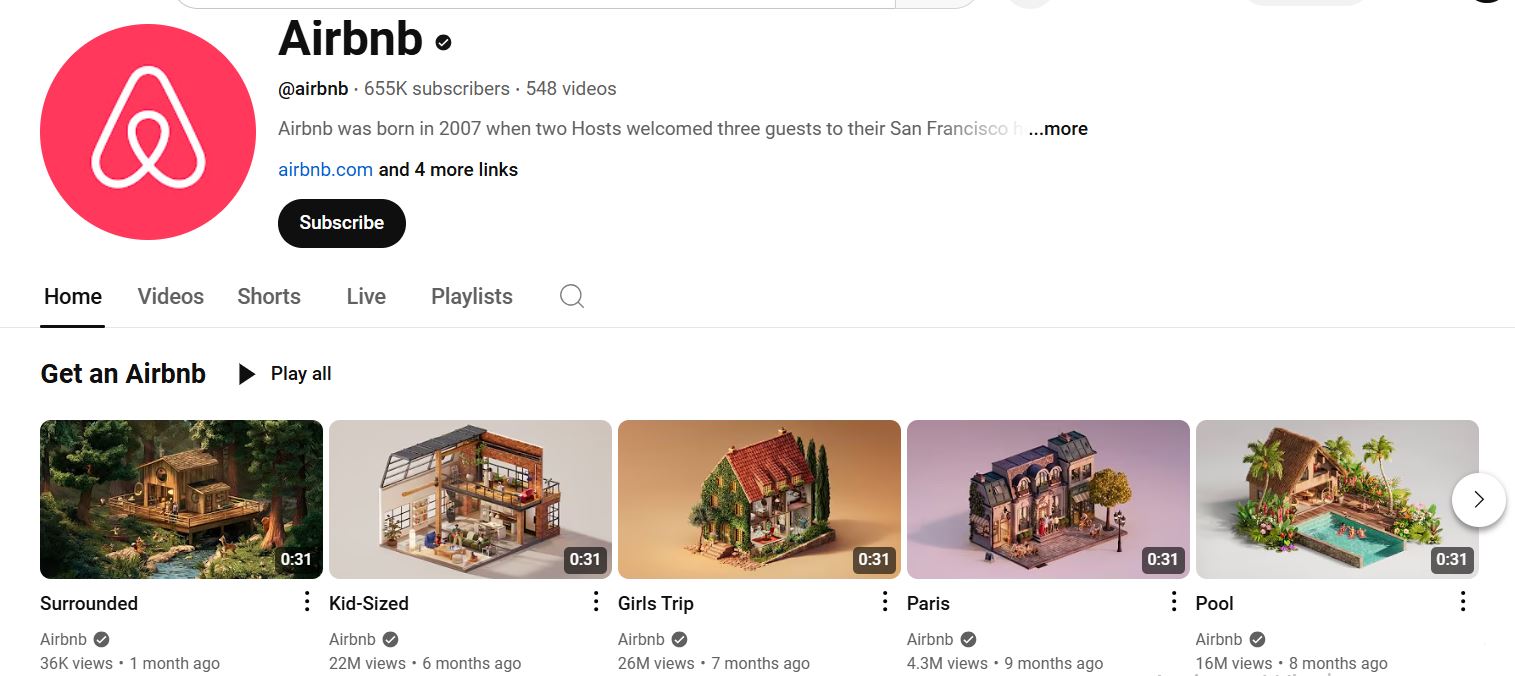- Details
- Online Advertising
- Hits: 258
How to Best Promote Your Safety Training Company: SEO Tips for Online Growth
The #1 best way to promote your safety training company is to showcase real client success stories through targeted digital ads and SEO-optimized content that builds trust and highlights your certifications. At some point, every business understands the importance of search engine optimization. And like it or not, safety training companies are no exception. Still, if you haven’t done SEO before, it might seem extremely confusing. That’s why many postpone this whole thing for as long as they can.
But it isn’t the best strategy, as ignoring SEO for safety training companies means being invisible to prospective customers — the very people who may be searching for safety solutions. So, how do you ensure this doesn’t happen to your business?
That’s exactly what we’ll discuss in this post, along with the SEO tactics you need to make sure your company keeps growing.
Click on each corresponding link to jump ahead:
- Prioritize Guest Posting
- Increase your online visibility and domain authority by publishing high-quality guest posts on relevant websites in your industry.
- Take Advantage of Press Releases
- Use press releases to gain media coverage and improve your site’s credibility with backlinks from reputable outlets.
- Collaborate With Influencers/ Related Brands
- Partner with industry influencers or businesses to expand your reach and drive referral traffic to your website.
- Take Landing Page Optimization Seriously
- Optimize your landing pages by using targeted keywords and compelling content to convert visitors into customers.
- Create Expert Blogs
- Establish your brand as a thought leader by creating informative blogs that address your customers’ needs at all stages of their journey.
- Make Sure Your Website Is Responsive
- Ensure your website is mobile-friendly and functions well across all devices to enhance user experience and improve SEO.
- Check Your Page Is Secure
- Secure your website with HTTPS and SSL certificates to protect user data and improve your site’s ranking on Google.
- Fix Anything That Can Cause Latency and Affect Page Load Time
- Improve your SEO by ensuring fast page load times, aiming for a website that loads in 3 seconds or less.
- Email Marketing
- Use targeted email campaigns to engage with your audience, drive traffic back to your website, and enhance your SEO efforts.
If you are looking for help with promoting your safety training company, contact Profitworks today.
8 Safety Training Company SEO Tips You Need for Growth
SEO is not just cheaper than PPC, it’s also best aligned to long-term growth. Overall, there are three aspects to SEO:
- Off-page SEO: Everything you do outside of your site to make it more powerful (guest posting, press releases, collabs, etc.). These are the most “aggressively” promotional SEO tactics — even though SEO isn’t really that promotional.
- On-page SEO: Everything you do on your website to optimize it (keyword research, quality content, etc.). This basically covers most of the SEO best practices out there.
- Technical SEO: This is probably the hardest part of SEO that might involve some dev and coding skills (page speed, security, redirects, etc.). It’s all about great performance and functionality here.
The best way to get your safety training company out of the dark corners of SERPS and into the spotlight is to use all three. So, let’s see the best tactics for each of them.
1) Prioritize Guest Posting
What Is Guest Posting and How I Used It To Increase Our Reach by 1100% and +7 DA in 30 days
Guest posting is one of the most powerful ways to increase your safety training company’s online visibility. It involves writing informative, high-quality articles for other websites—ideally those related to occupational safety, training, construction, or industry compliance. This strategy puts your brand in front of a highly targeted audience and helps establish your authority in the safety training space.
When you publish guest posts on relevant and reputable websites, Google sees this as a vote of confidence in your credibility. It signals to search engines that you’re an expert in workplace safety and compliance—an important factor that can boost your search engine rankings. Plus, backlinks from these guest posts contribute directly to improving your domain authority, which helps your own site rank higher over time.
However, guest posting isn't always easy, especially if you’re new to outreach or don’t have a network of publishers in the industry. If that’s the case, consider partnering with a reputable SEO agency or using a link-building platform to streamline the process. Some platforms specialize in connecting businesses with niche websites, making it easier to get your safety expertise featured on sites that matter.
Adsy recommends that you don’t make a commitment up front when using any of these options. A better strategy would be to sign up for a trial first so you get a feel of what they’re like before you commit.
Pro tip: Before committing to any guest posting service, take advantage of trial offers to gauge the quality and fit of the platform or provider. That way, you’ll make informed decisions without wasting your marketing budget.
2) Take Advantage of Press Releases
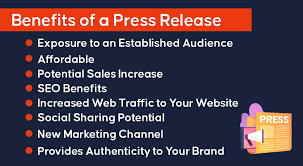
Source: Inquivix
Press releases are an often-overlooked SEO tool that can help safety training companies build trust, earn authoritative backlinks, and drive targeted traffic. By distributing a well-written press release through a trusted media outlet or PR platform, you can spread news about your company, such as a new safety course launch, updated certifications, client partnerships, or community involvement.
Not only does this strategy help you get in front of a wider audience, but it also provides valuable off-page SEO benefits. When media outlets or news blogs publish your release and include a link to your website, it signals to search engines that your brand is credible and worth ranking. These backlinks can help improve your domain authority and push your site up the search results.
To make this strategy count, aim to get featured on platforms with solid domain authority and industry relevance. That could be national news outlets, business directories, or even industry-specific portals focused on workplace safety, HR, or compliance. Make sure your press release is professionally written, timely, and newsworthy—don’t just make it a sales pitch. Tell a story that safety officers, HR managers, or business owners would care about.
If you’re not comfortable writing the release yourself, consider hiring a copywriter or PR specialist who understands your industry. Also, look into reputable distribution services like EIN Presswire, PR Newswire, or safety industry-specific news outlets for maximum visibility.
3) Collaborate With Influencers/ Related Brands
How to 10x Your Business Overnight with Influencers
Collaborating with influencers or complementary brands is a powerful off-page SEO tactic that can significantly boost your safety training company’s visibility. While guest posting and press releases are great starting points, teaming up with trusted voices in your industry can take your promotional efforts to the next level.
For the safety training sector, this often means working with other businesses or professionals who can benefit from your services, such as construction firms, HR consultants, or corporate safety officers. Rather than partnering with traditional “influencers,” which may be rare in the safety niche, consider collaborating with well-established brands or professionals who already have an audience that values workplace safety and training.
For example, you might offer a tailored training session to a local construction company, and in return, they share their positive experience with their own audience. This collaboration provides social proof and generates word-of-mouth referrals, which can lead to valuable traffic to your website.
In addition, these collaborations can result in backlinks when partners mention your services on their blogs or social media, which helps your SEO rankings. The key is to identify businesses that are relevant to your audience and ensure the collaboration feels authentic and mutually beneficial.
4) Take Landing Page Optimization Seriously
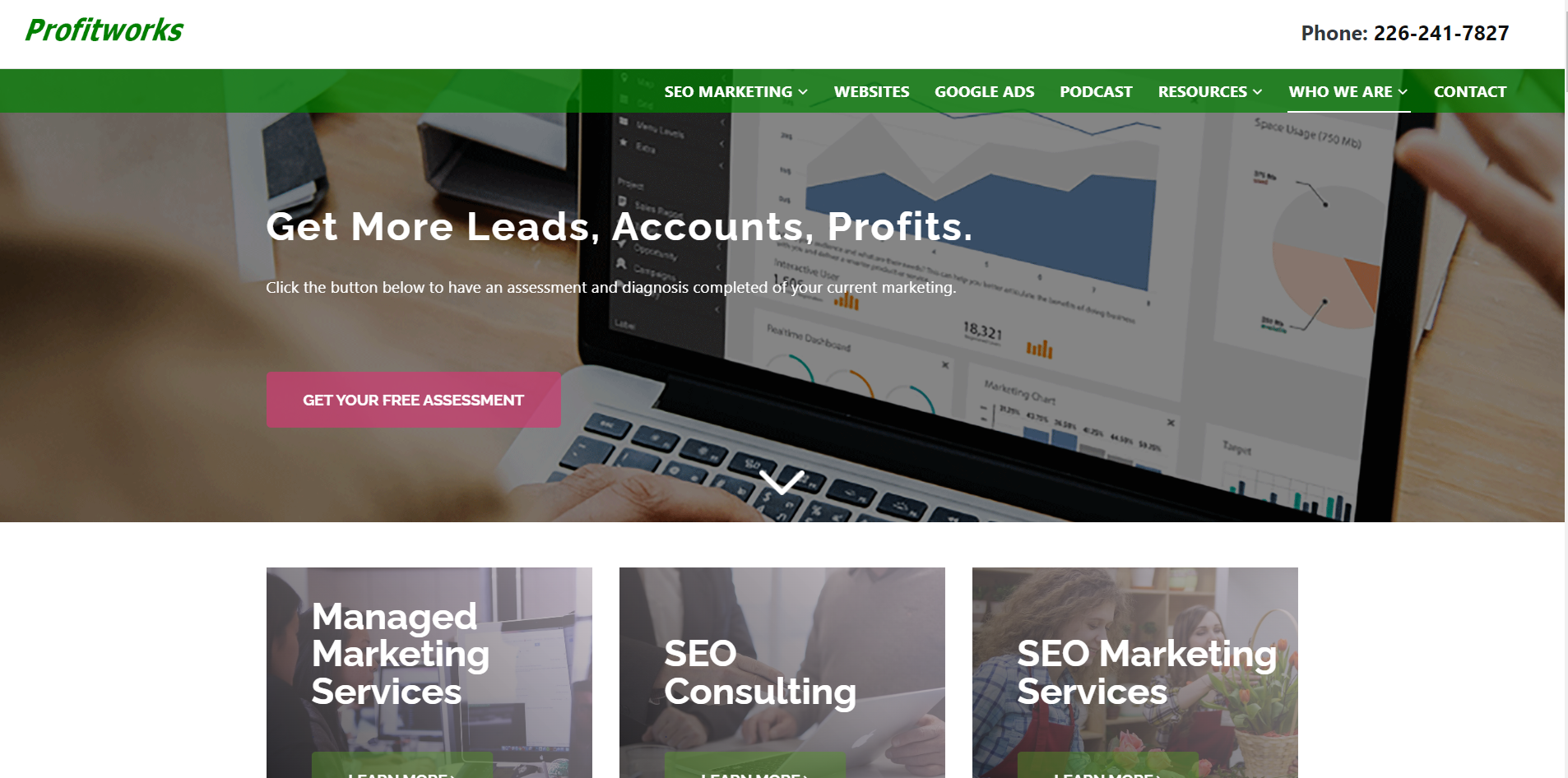
Source: Profitworks
An optimized landing page is key for driving conversions and improving SEO. Ensure your content clearly communicates what your safety training business offers while being optimized for search engines.
Incorporate relevant keywords naturally across your page, especially in the content, headers, meta descriptions, and image alt texts. Use tools like Semrush or Ahrefs to identify keywords your potential customers are searching for. Focus on addressing your audience’s pain points and highlighting how your training solves their challenges, whether it’s through superior compliance, cost-effectiveness, or other unique selling points.
Social proof is essential—include testimonials, reviews, and video testimonials to build trust. High-quality images and videos of your training programs in action can also help increase credibility and engagement.
Lastly, your call-to-action (CTA) should be clear and action-driven. Use active verbs like “Sign Up” or “Get Started” to guide visitors toward the next step and boost conversions.
5) Create Expert Blogs
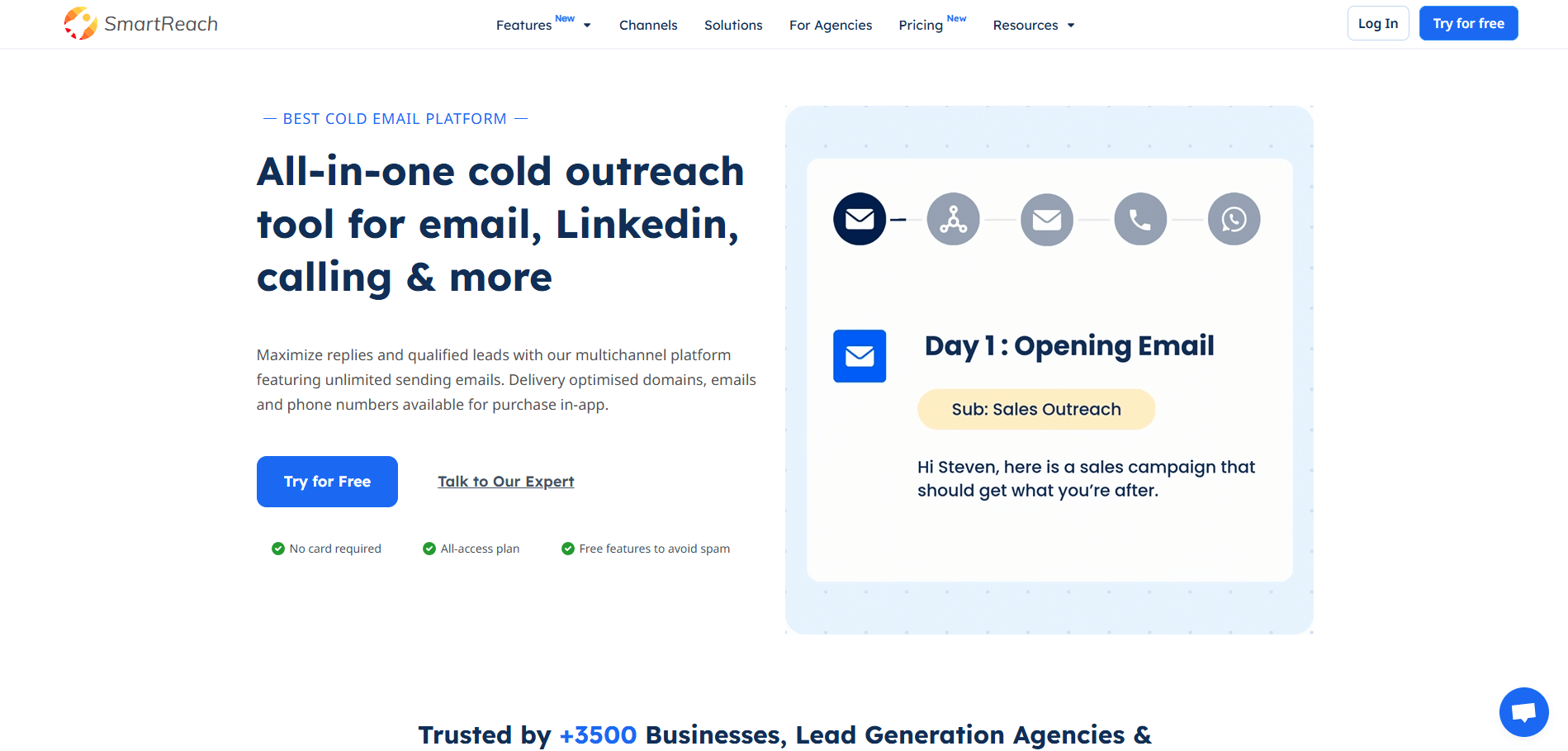
Source: SmartReach
Content has ruled the SEO world for the longest time, and it doesn’t look like that’s changing anytime soon. That’s why SmartReach.io recommends blogging for businesses interested in sustainable growth and lead generation. For your safety training company, a well-executed blog strategy can become one of your most effective marketing tactics.
It starts with understanding what your customers are looking for. This is where keyword research comes in—tools like Semrush or Ahrefs can help identify the terms your target audience is searching for.
Then, use those keywords to create expert blogs. It’s important to have experienced writers who know how to craft compelling content that not only incorporates keywords but also tells a story that draws readers in.
Your blog should cater to all stages of the buyer’s journey:
-
Awareness: Provide informational content, how-to guides, and safety tips.
-
Consideration: Offer product comparisons, case studies, and in-depth explanations of your training programs.
-
Decision: Showcase testimonials, free demos, and other resources to help potential clients make their final decision.
The more your content offers real solutions and adds value, the more you’ll solidify your brand as a thought leader in the safety training industry.
6) Make Sure Your Website Is Responsive
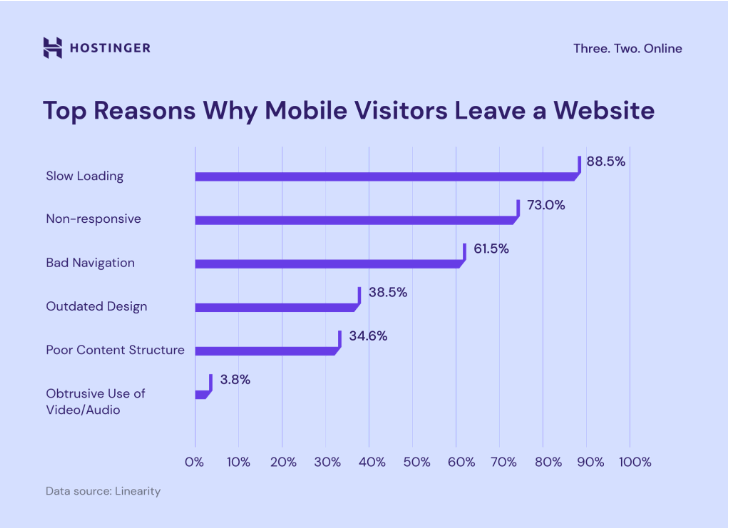
Source: Hostinger
So far, we've covered the “front-end” of your company’s website, focusing on making it appealing to both humans and search engine algorithms. Now, it's time to turn our attention to the “back-end” to ensure everything functions as it should.
Imagine a website that looks great but doesn’t work properly—that’s a disaster waiting to happen. To avoid this, you need to focus on technical SEO.
The first step in technical SEO is ensuring your site is responsive. Google prioritizes the mobile version of a website first because over half of all internet traffic comes from mobile devices. This means your website must load quickly and be easy to navigate on smartphones and tablets. Avoid cluttering your site with excessive pop-ups and ads, and ensure buttons are large enough to be easily clickable on mobile screens.
By optimizing your website for mobile, you'll improve user experience and boost your search engine rankings.
7) Check Your Page Is Secure
Top 5 Website Security Tips
It would be ironic for a safety training company website to be unsecured, right? While the idea of website security may seem like a distant concern, it's a critical aspect of maintaining trust and credibility. Google takes website security seriously, so it’s essential to ensure your site uses a secure HTTPS connection and has an SSL certificate installed.
Regular cybersecurity training for your internal team is also crucial to prevent potential breaches and protect your company’s reputation. As a safety training provider, you’re already familiar with the importance of security, so make sure your website reflects that.
From an SEO perspective, it’s essential to audit your site regularly—at least once a month. This is especially important if you rely on paid SEO links or use AI-generated content frequently. Regular audits help ensure you avoid Google penalties, traffic drops, and other issues that could harm your rankings.
8) Fix Anything That Can Cause Latency and Affect Page Load Time
10 Ways to Make Websites FASTER
The pages that rank in the top 3 on Google typically load in 3 seconds or less. If you're serious about improving your SEO rankings for your safety training company, ensuring your page load time is fast is essential.
This can get technical quickly, so start by checking your website’s performance using Google’s PageSpeed Insights. The tool will provide detailed insights into what’s slowing down your website. If the fixes are simple, you can make the adjustments yourself.
However, if you encounter more complex issues, consider hiring a freelance developer to help optimize your site’s speed, especially if you don’t have an in-house developer on your team.
9) Email Marketing

Source: Mailchimp
Email marketing is a powerful tool for staying in touch with your audience and nurturing relationships, which is essential for driving repeat business and promoting your safety training services. With the right strategy, email marketing can significantly boost your SEO efforts by driving traffic back to your site.
Start by building a quality email list—ensure it’s made up of engaged individuals who have shown interest in your services. Offering a free resource or a valuable tip related to safety training can help incentivize sign-ups.
Once you have your list, segment it based on factors like location, company size, or the type of safety training services they're interested in. Tailor your content to address their specific needs and pain points, whether that’s information on workplace safety regulations or updates on new training programs.
Don't forget to include clear calls to action (CTAs) in your emails that encourage readers to visit your website, check out your blog posts, or sign up for a training session. A well-crafted email campaign can drive significant traffic and improve your overall SEO performance.
- Details
- Ian McLaren
- Online Advertising
- Hits: 225
The #1 tip for for to craft captivating marketing graphics is to focus on clarity and simplicity to ensure your message is instantly understood.
In this article, you will learn about:
-
Getting Attention - How to create striking visuals that stop the scroll.
-
Why Good Design Is Everything in Marketing - The importance of memorable branding and visual storytelling.
-
The Many Benefits of Strong Marketing Graphics - Boost brand recognition, increase engagement, and drive conversions.
-
What Makes a Marketing Graphic Truly Effective? - Core design principles like simplicity, hierarchy, and emotional appeal.
-
How to Create Effective Marketing Graphics - Practical steps for designing impactful visuals.
-
Wrapping Up - Final thoughts on ensuring your graphics communicate effectively.
If you're a small to medium-sized business looking for help to craft captivating marketing graphics, contact Profitworks today!
1. Getting Attention
How many times have you experienced the following phenomenon: you're scrolling through your feed as you normally do, when a striking image or video stops you dead in your tracks; you abandon what you were doing (most likely, aimless doom-scrolling) and follow the link on said image or video. We can already guess: you've experienced it a handful of times, if that much.
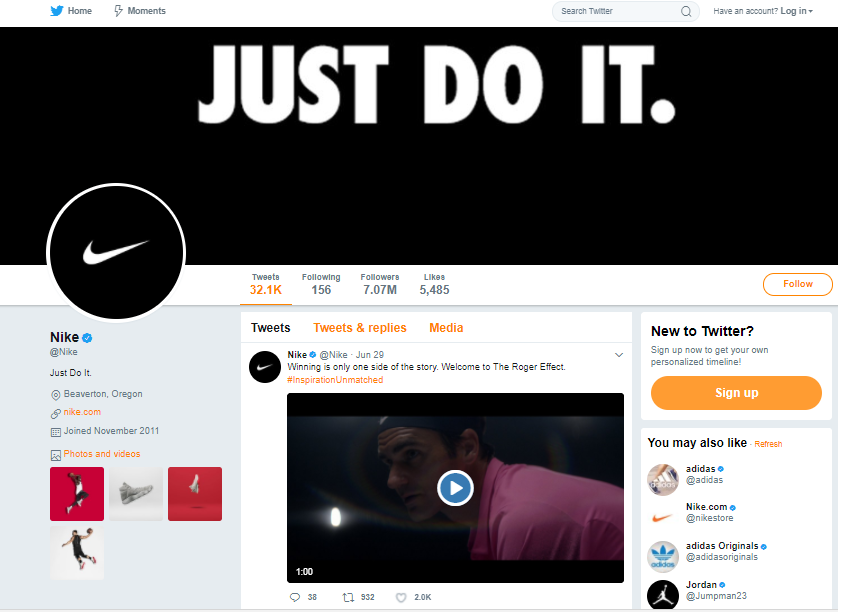
You know how we know this? Because we know from first-hand experience how difficult it is to get someone's attention in this day and age, marked by increasingly loud digital noise. It's so difficult, in fact, that when it actually happens, you, as a marketer, feel like you've struck gold.
But what does it actually take to strike this marketing gold? More than anything, great marketing graphics.
Mind you, "great" visuals don't just look great – they persuade. In other words, they pull you in, communicate a message (sometimes in a second or less), and leave an impression that sticks. And this is true whether you're running ads, promoting a product, or building brand awareness: marketing graphics can be (and more often than not are) the difference between being ignored and making an impact.
So, the question is: what separates a design that gets attention and converts from one that fades into the background along with the rest? How do you create high-quality graphics that don’t just look professional but truly drive real results for your business?
2. Why Good Design Is Everything in Marketing
Take a moment to think about brands like Apple, Nike, or McDonald's; what was the first thing that came to your mind? We can bet it’s their logo, a.k.a. visual design. Yes, these brands are iconic, and so are their logos, but the point remains: the first thing that comes to your mind when you think of a big brand is a simple visual. Why is that? Because we all think in symbols.

If you think about it, it's all really simple: we automatically associate simple symbols with complex ideas because we process visuals much faster than text.
Hence why logos and branding elements carry so much weight in marketing, and why they need to be calculated and intentional (while appearing effortless). And when we say “intentional”, we mean exactly that: yes, good design looks nice, but more importantly, it communicates the message you or your brand is trying to get across. It also reinforces brand consistency and, in the end, persuades the viewer to take action.
Here's a fun fact for you that confirms everything we've talked about until now: the human brain processes images in as little as 13 milliseconds. That means a strong, well-designed graphic can tell a story before a single word is read. Talk about power!
Source: Tesla.com
But what's even more interesting about marketing visuals is that they can do what text alone can’t: create an emotional connection between the audience and your brand. A single powerful image can communicate a feeling, tell a story, or inspire action faster than paragraphs of copy.
Of course, branding isn’t just about logos. Every digital ad, social media post, email banner, and product package contributes to the overall perception of your business, so each segment requires thoughtful planning, as well as consistency.
The latter is especially important because it builds trust, and trust leads to customer loyalty. Research confirms this: according to a study by Lucidpress, businesses that maintain consistent branding see an average revenue increase of 33%.
3. The Many Benefits of Strong Marketing Graphics
We already mentioned that great marketing visuals won't just make your brand look good (cool, elegant, luxurious, etc., depending on your goal); it will have tangible benefits for your business. Below are just some of them.

Boosts Brand Recognition
When your marketing visuals are well-designed and consistent across the board (colors, fonts, and visual styles), they can make your brand more recognizable. This is simple logic: the more people see a familiar design, the more they remember you. Of course, this takes time, but it's important to get it right from the start - be intentional and be consistent with your marketing graphics.
Enhances Engagement
What are you more likely to share and click on: interesting, visually appealing content, or one that lacks images but is dense in text?
If you're anything like most people, it's the former. This is why you want really strong graphics in your marketing materials - they're more likely to be shared, liked, and commented on, all of which is necessary if you want to improve email open rates and drive website traffic.
Increases Conversions
The ultimate goal of marketing is (usually) to increase sales. And certain design elements in your marketing materials - like strong calls to action, well-placed product images, and eye-catching headlines - are absolutely essential for this task. When done well, they push viewers toward action, whether it’s buying, signing up, or engaging with your brand.
Builds Trust and Credibility
Do you want your business to signal credibility and trust? If yes, you need a professional, well-designed visual presence. It's non-negotiable. Of course, it takes more than just great marketing graphics for a brand to become synonymous with credibility - you also need positive customer reviews, and lots of them - but it's an important piece of the puzzle, nonetheless.
Why? Again, humans are visual creatures, so even if you have years of experience in your field and a ton of great reviews, if you use poor visuals in your marketing, most potential customers will question your legitimacy.
Simplifies Complex Messages
If you have a great product or a service but are not sure how to communicate its purpose clearly to the audience, turn to visual elements like infographics, charts, and icons.
They all make it easier and quicker to convey complex ideas, and unlike text-heavy explanations, they don't overwhelm the audience. With the right visual graphics, you can communicate key points in an easily digestible as well as visually engaging way.
4. What Makes a Marketing Graphic Truly Effective?
What Makes a Marketing Graphic Truly Effective?
Alright, now onto the juicy part: what exactly makes a graphic design effective, meaning, able to drive results (whatever they may be for you)?
First, let's acknowledge the fact that aesthetics matter. Of course, they do - after all, we've mentioned numerous times that people are visual creatures and when something looks good (whether that's another human being or an ad), we're more likely to pay attention to it. However, what matters even more is that the pretty visuals serve their purpose and drive an intended response.
Now, while design choices should align with your brand, product, and message, certain principles for creating effective marketing graphics apply across the board. Here they are.
Clarity and Simplicity
You want one simple (but in reality difficult) thing from your marketing graphics: to communicate a message fast. The latter is important because the average person gives an ad or social media post only a second or two before deciding whether to engage or scroll past. So how do you achieve this impossible task? With a simple but clear design.

Source: Pixabay
Simplicity is best because it ensures quick comprehension. Overly complex designs with too much text, excessive detail, or clashing colors, on the other hand, are likely to lose people before they even process your message. Why? Because it overwhelms rather than engages.
How to have clear and simple graphics:
- Use white space to avoid clutter and keep designs from feeling cramped.
- Stick to a single focal point, whether it's an image, logo, or main text.
- Avoid excessive fonts and colors; two to three complementary colors and a maximum of two fonts are ideal.
- Make sure the text is large enough to be legible at a glance.
Strong Visual Hierarchy
Good design guides the viewer’s eye toward the most important information, and this is not possible without a clear visual hierarchy. In fact, without it, key elements may get lost, reducing the effectiveness of your marketing, maybe even nullifying it.

Spotify Wrapped is effective because it offers personalized, shareable content that taps into users' emotions and sense of identity by celebrating their unique listening habits. Its interactive design, social media integration, and use of data storytelling create a sense of exclusivity and community, encouraging widespread sharing and brand engagement.
Speaking of key elements, it's also important to invest in high-resolution photos, vector graphics, and sharp typography. What if your budget is small and you're limited to stock images? Be extra cautious and picky because generic or overused visuals will just make you blend with the rest of the brands.
How to create strong hierarchy and ensure the effectiveness of your marketing visuals:
- Use size, color, and contrast to emphasize important elements.
- Place key information (like a call to action) in the most visually dominant area.
- Align elements purposefully to create a logical reading flow.
- Use only high-quality images and sharp typography that feel professional and polished.
Brand Consistency
Your marketing graphics should be unmistakably you. This is the consistency we talked about before - it matters, and greatly so, because it builds trust and recognition.
But how do you achieve this?
By sticking to a consistent color palette, typography, and visual style across all platforms. The goal is for a (potential) customer to recognize your content wherever they see it (whether on social media, a website, or a billboard) and instantly associate it with your company.

Here’s how you can do this:
- Use a defined color palette that complements or supports your message/makes sense for your brand.
- Make sure your typography is consistent across all materials.
- Have a cohesive visual style, whether through photography, illustrations, or iconography.
- Ensure that your logo is correctly placed and proportioned.
Emotional Appeal
Here’s the secret sauce to a compelling marketing strategy: appeal to human emotions, not reason.
Why?
Because we make decisions based on feelings, and then justify them with logic.
This is why the best marketing graphics tap into emotions, which can be anything from excitement to nostalgia to urgency, all the way to love and trust.
Source: Dove
An example of an emotionally appealing marketing graphic is Dove’s “Real Beauty” campaign. The graphics featured women of all shapes, sizes, and ethnicities, celebrating natural beauty and self-acceptance. The visuals evoke feelings of inclusivity, confidence, and self-love, encouraging viewers to redefine beauty standards and embrace their authentic selves, while strengthening Dove's message of empowerment and body positivity.
How to add emotional appeal to your marketing graphics:
- Choose images that resonate emotionally with your audience (happy customers, aspirational lifestyles, etc.).
- Use color psychology: red can create urgency, blue builds trust, and yellow evokes positivity.
- Pair strong visuals with emotionally compelling copy.
Readability and Accessibility
Beautiful, aesthetically pleasing, or simply pretty – call it whatever you want, but the way your marketing visuals look matters.
But – and this is a crucial but – what matters equally as much is that it’s easy to read or understand. Because the truth is, a beautiful design is pointless if people can’t read it (and yes, we do mean at a glance, which is what the average scroller will give to your ad).
This is why you need to make your visuals accessible to the widest audience possible, including those with visual impairments. So, fonts should be readable, on-brand, and suited to your message, and any visual elements should be simple and clear.
Source: https://www.youtube.com/airbnb
For example, Airbnb's ad campaigns often use simple, clean design with high-quality images and clear, legible fonts. The visuals are striking, with minimal clutter, and the text is easy to read even on mobile screens. The images evoke feelings of wanderlust and comfort, while the straightforward messaging ensures viewers can quickly grasp the idea — making it both visually appealing and effective in conveying the brand's message.
How to implement this tip:
- Use high-contrast color combinations to enhance legibility.
- Avoid using decorative fonts for large bodies of text.
- Test designs on different screen sizes and in grayscale to ensure clarity.
- Add alt text and captions for digital graphics to improve accessibility.
Call to Action (CTA)
Finally, since the whole point of marketing is to inspire action, a strong CTA is essential, whether you're creating videos, posters, or static digital ads. In fact, if there’s no clear CTA, you’re leaving money on the table.
Whether it's making a purchase, signing up, or clicking a link, your CTA must be clear and compelling.
Source: amazon.com
For example, Amazon's Prime Day campaigns often feature bold and direct CTAs like “Shop Now” or “Get 30% Off Today.” These CTAs are placed prominently on their banners and ads, making it immediately clear what action the viewer should take. The urgency created by phrases like "Today Only" or "Limited Time Offer" further compels users to click and make a purchase, driving higher conversion rates. The clarity and immediacy of these CTAs ensure that potential customers are not left wondering what to do next, making the marketing more effective.
How to have a strong CTA:
- Use direct, action-oriented language (e.g., "Shop Now," "Get Started," "Sign Up Today").
- Make the CTA button or text prominent in size and color.
- Ensure the CTA stands out from other elements without feeling intrusive.
5.How to Create Effective Marketing Graphics
Now that you know what works, here’s how to put it all together.
1. Understand Your Audience
Effective design starts with knowing who you’re speaking to. So, who is your main audience? Because a graphic meant for Gen Z on TikTok will look very different from one targeting corporate executives on LinkedIn.
To tailor your design:
- Research audience preferences, including preferred colors, styles, and formats.
- Analyze successful competitors to see what resonates with your shared audience.
- Design for platform-specific expectations (e.g., bold, colorful for social media; clean, professional for email marketing).
2. Use High-Quality Images
Blurry, pixelated, or generic stock images can make any brand (even an established one) look unprofessional. High-quality visuals, on the other hand, enhance credibility and engagement, so stick to them only.
Simple things to remember:
- Only use high-resolution images and vector graphics.
- Opt for original photography when possible.
- If you're using stock images, customize them to fit your brand rather than using them as-is.
3. Optimize for Different Platforms
In this day and age, marketing graphics must be adaptable. A design that looks great on a desktop ad is fantastic, but if it’s unreadable on a smartphone, it’s not good enough.
You can optimize for different platforms by:
- Creating responsive designs that scale well across devices.
- Using tools that allow you to resize graphics effortlessly.
- Testing how your graphics appear in different formats before publishing.
4. Use Templates for Efficiency
Creating high-quality graphics from scratch every time is inefficient, at the very least. This is why you want to use templates when possible. They provide a strong starting point while maintaining professionalism and brand consistency. Plus, they save time.
To be as efficient as possible:
- Customize posters online using platforms like Canva.
- Build a library of reusable templates for different campaigns.
- Adapt templates with unique elements so designs don’t look generic.
5. Take Advantage of Color Psychology
Don't sleep on the power of colors: they evoke emotions and can influence consumer behavior, so use them wisely. Choose a color palette that aligns with your brand's personality and the emotions you want to elicit from your audience.
For instance, blue often conveys trust and professionalism, while red can evoke excitement and urgency.
6. Stay on Top of Design Trends
While you don't have to follow every trend (in fact, it's best you stay true to your main values and follow only those trends that support them), if you want to remain relevant in today’s marketing landscape, you should, at the very least, modernize your graphics. You want to maintain a fresh, relevant brand presence at all times.
Here’s how you can do that:
- Follow design trend reports from reputable sources like Adobe or Canva.
- Experiment with emerging styles but ensure they align with your brand identity.
- Avoid overused trends that might quickly become outdated.
Again, while trends can keep your visuals fresh, it's best to balance them with timeless design principles to avoid frequent rebranding.
7. Test, Iterate, and Improve
Finally, it’s important to understand that good design is an ongoing process. Trends change, so do consumer behaviors and preferences, and if you want to remain competitive and relevant, you need to continuously improve upon your designs.
You can do this by constantly testing variations, gathering feedback, and refining your visuals to optimize engagement.
6. Wrapping Up
Just like in real life, looking good can get you far in marketing. But to inspire action in the audience, marketing visuals need to be more than pretty to look at – they have to communicate your message effectively. This is why every design choice, from color to typography, should serve a purpose.
Keep your designs clear, engaging, and on-brand, and you’ll see the difference where it matters most - your results.
- Details
- Hits: 340
A Guide to Understanding the Difference Between Free and Royalty-Free Vectors for Countertop Business Marketing
The #1 way to know if an image is royalty free or not is to check the licensing information provided by the source of the image, as it will clearly indicate whether the image is royalty-free or not. Vector graphics can help small businesses create eye-catching designs without investing exhausting efforts. But navigating the options can be tricky, especially when you need to choose between free-to-use and royalty-free vector images. Choosing the right type depends on your project’s purpose and licensing needs. Read further to understand their differences, benefits, and limitations and make the best decision for your projects and budget.
Discover royalty free vectors on Depositphotos to use top-quality images in your creative projects
Click on each corresponding link to jump ahead:
- The Difference Between Free-To-Use and Royalty-Free Vectors
- What Are Free-To-Use Vectors?
- What Are Royalty-Free Vectors?
- Free-To-Use or Royalty-Free Vector Images: What to Choose for Your Small Business
- Pros and Cons of Free-To-Use Vectors
- Pros and Cons of Royalty-Free Vectors
- What Does Royalty Free Vector Mean
- What Is the Difference Between Royalty Free and Copyright Free
- Which Option Should Your Countertop Business Choose?
If you are a countertop company looking for help with image selection, contact Profitworks today!
1) The Difference Between Free-To-Use and Royalty-Free Vectors
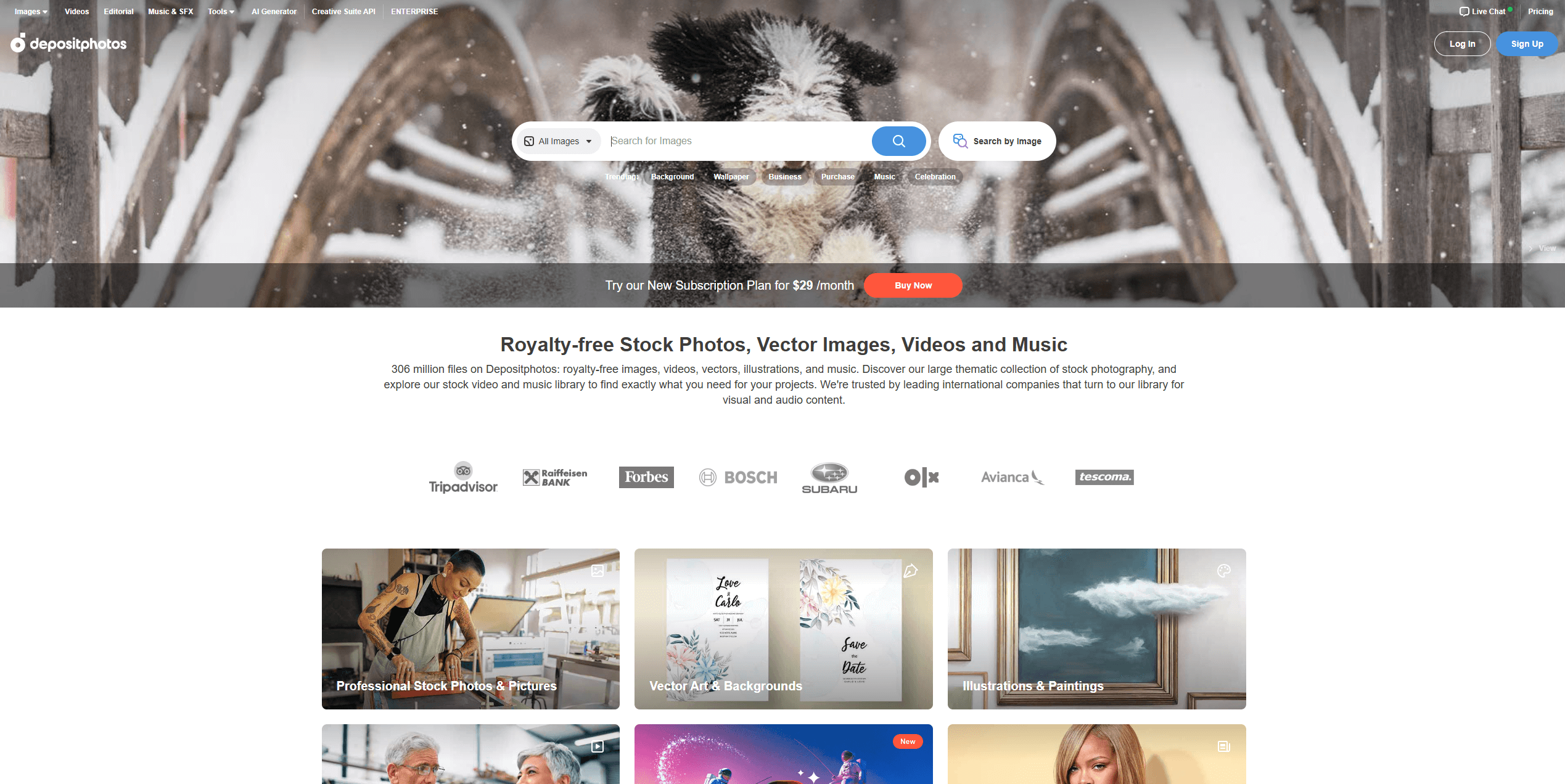
Source: Depositphotos
Before diving into the details, let’s clarify what a vector file is. Unlike standard image formats like JPEG or PNG, vector graphics (such as SVG, EPS, AI, and PDF) are made using mathematical formulas, making them fully scalable without losing quality. This flexibility is perfect for countertop businesses that need high-resolution visuals for everything from website banners to vehicle wraps.
Many countertop companies turn to stock image platforms to source vector graphics for marketing. That’s one of many reasons stock visuals made the top 3 best-performing types of visual content in 2024
2) What Are Free-To-Use Vectors?
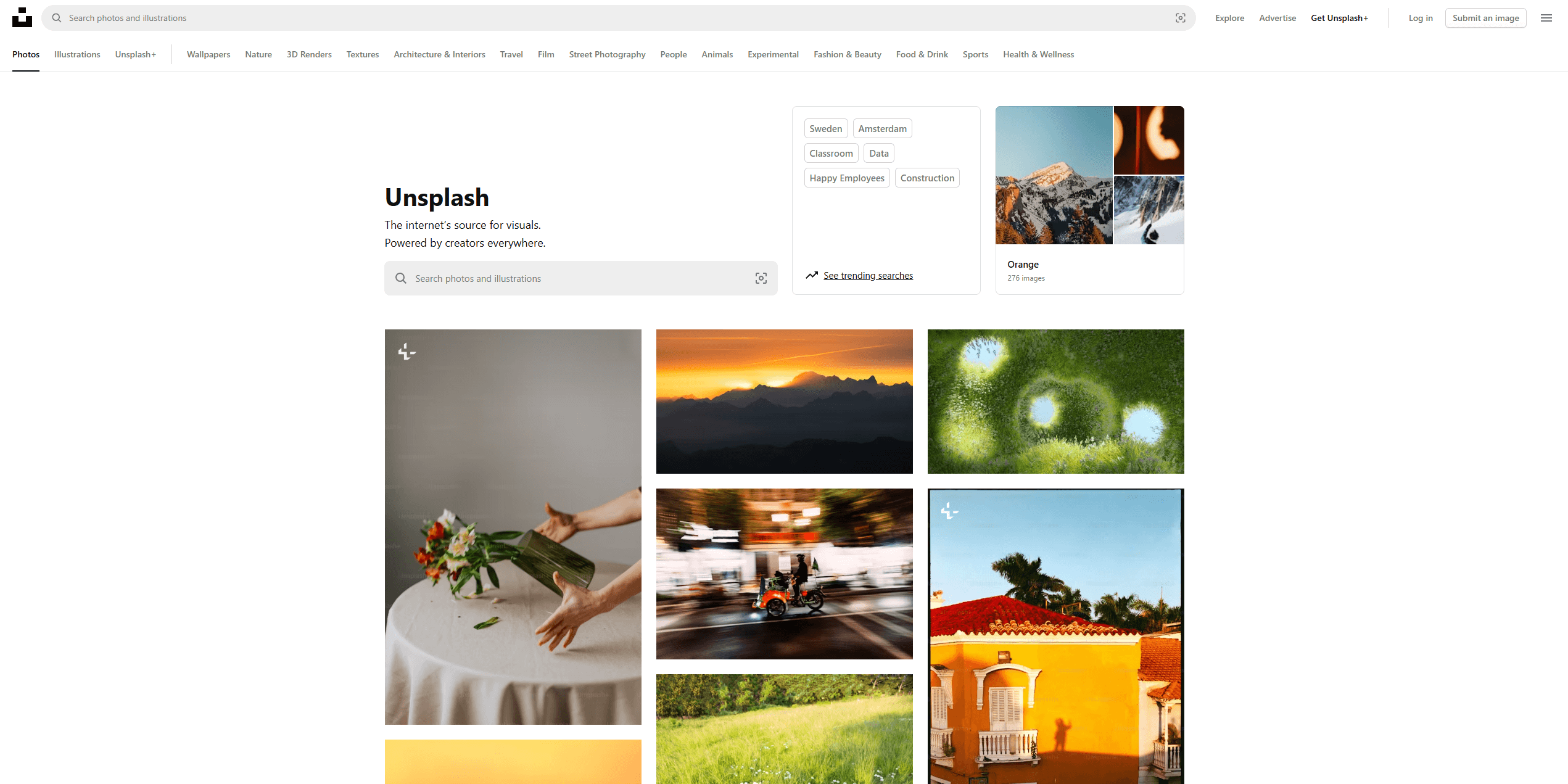
Source: Unsplash
Free-to-use vectors are digital images available without upfront payment, but their usage rights depend on the licensing terms set by the creator or platform.
Here’s how it works:
- Public domain vectors: Completely free for personal and commercial use without restrictions.
- Attribution-free vectors: No credit is required to use the image.
- Attribution-required vectors: You must credit the creator when using the vector.
- Personal-use vectors: Limited to non-commercial purposes (e.g., mood boards or concept sketches).
- Free for commercial use: Can be used in business materials, such as social media ads or website graphics, without additional fees.
3) What Are Royalty-Free Vectors?
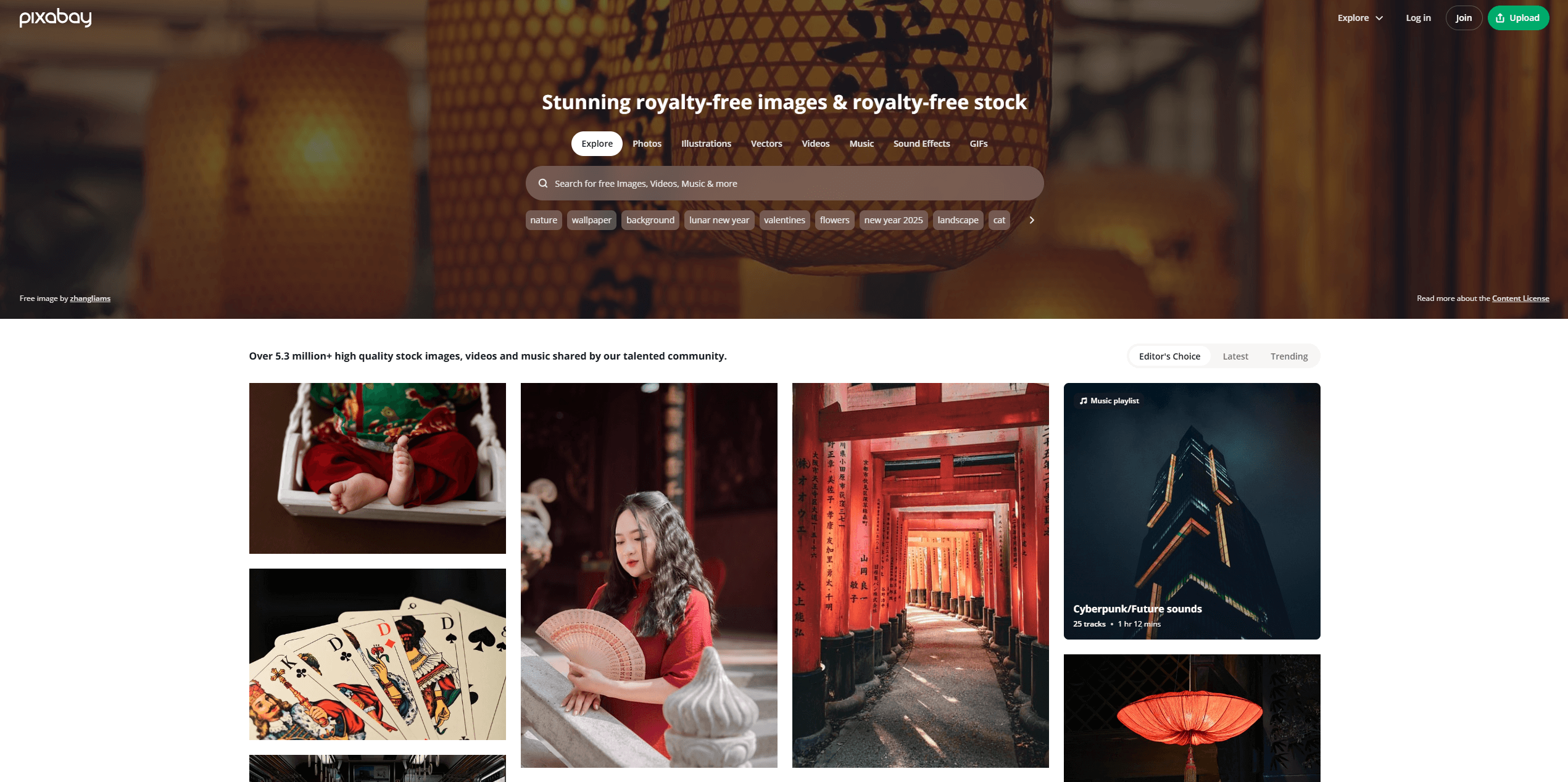
Source: Pixabay
Royalty-free vectors allow you to use the image without paying recurring fees. Once purchased, you receive a license to use the image under specific terms.
There are two types of licenses:
- Standard royalty-free license – Allows commercial use, such as advertisements, brochures, or countertop sales materials. However, resale and distribution may be restricted.
- Extended royalty-free license – Grants additional rights, such as using the vector on branded merchandise like aprons, cutting boards, or showroom displays. This can be quite a profitable option as the custom T-shirt printing market is expected to reach $9,883.2 million by 2033.
4) Free-To-Use or Royalty-Free Vector Images: What to Choose for Your Small Business
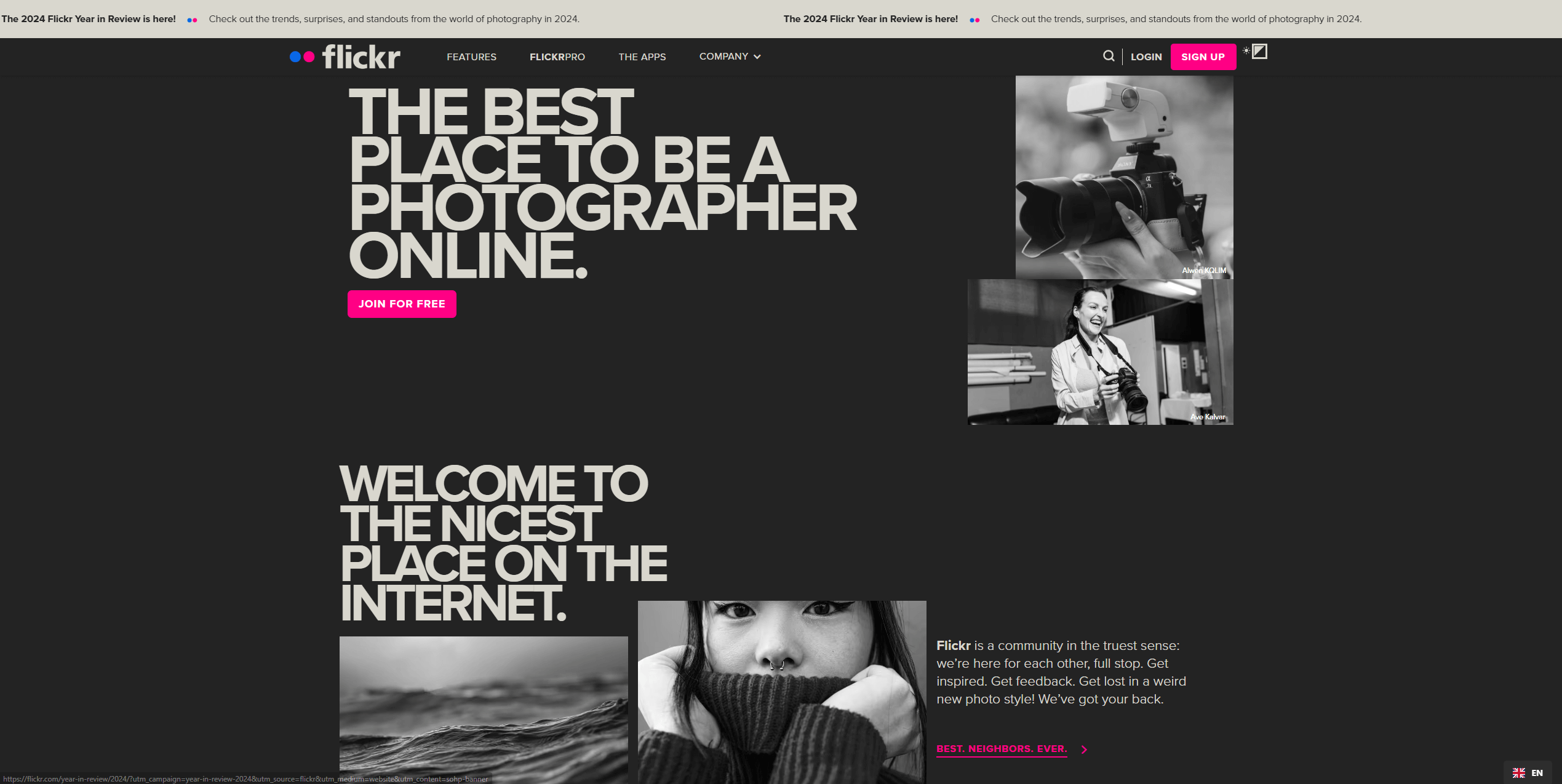
Source: Flickr
Choosing between free-to-use and royalty-free vectors depends on your countertop business’s marketing strategy, budget, and branding needs. If you’re looking for quick, no-cost visuals for social media or blog posts, free-to-use vectors might be the best option. However, if you need high-quality images for long-term brandings, such as product catalogues, website banners, or showroom displays, royalty-free vectors provide a more polished and professional look. Understanding the advantages and limitations of each option will help you make the right choice for your business.
5) Pros and Cons of Free-To-Use Vectors
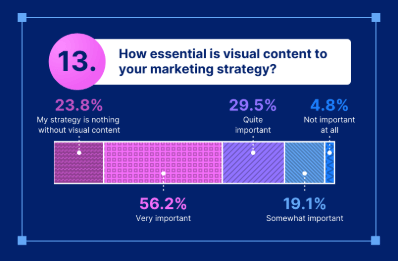
Source: Venngage
✅ Cost-effective – Free vectors are ideal for new or small countertop businesses with limited marketing budgets. They allow you to create professional-looking promotional materials without investing in premium graphics.
✅ Easy to access – Many stock image platforms offer free vectors, some of which include licenses that allow commercial use. This makes it simple to find visuals for ads, blog graphics, and website content without spending extra money.
❌ Limited customization – Free vectors often come with restrictions that prevent full customization. You may not be able to modify colours, resize certain elements, or remove unwanted details, which can make it difficult to align with your brand’s visual identity.
❌ Licensing restrictions – Some free vectors require attribution, meaning you must credit the original creator when using the image. Others are only available for personal use and cannot be used in advertising or commercial projects. Always verify licensing terms before using free vectors in marketing materials.
❌ Lack of exclusivity – Because free vectors are widely available, competitors in the countertop industry may be using the same designs. This can make your brand’s visuals feel less unique and diminish your company’s ability to stand out in a crowded market.
6) Pros and Cons of Royalty-Free Vectors
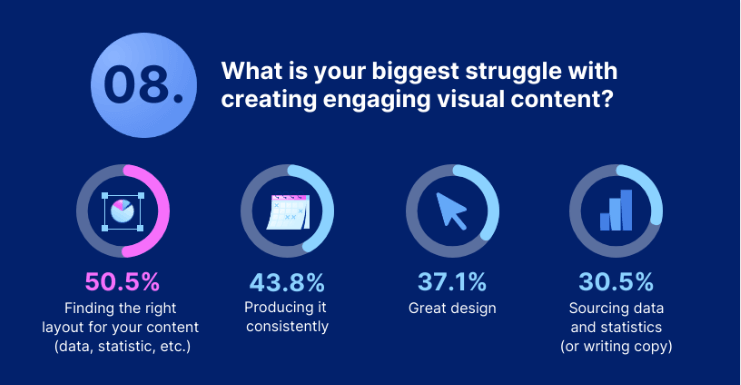
Source: Venngage
✅ Professional quality – Royalty-free vectors are often designed by professionals, ensuring they have a polished, high-resolution look. This is especially important for countertop businesses that want to maintain a premium image in their marketing materials.
✅ Commercial use allowed – With a standard royalty-free license, you can use these vectors for advertisements, brochures, vehicle wraps, and showroom signage without worrying about ongoing fees. This makes them a great choice for countertop companies investing in long-term branding.
✅ Customizable – Unlike many free-to-use options, royalty-free vectors allow greater flexibility. You can modify colours, add branding elements, and adjust designs to better match your company’s aesthetic. This ensures that your marketing materials remain cohesive and visually appealing.
✅ Less common – Since royalty-free vectors require a purchase, fewer companies will use the same images. This means your countertop business can maintain a more distinct and professional appearance compared to competitors relying on free images.
❌ Upfront cost – While "royalty-free" means you don’t have to pay recurring fees, you still need to purchase the image or subscribe to a stock image platform. For small businesses with tight budgets, this upfront investment can be a consideration.
❌ License restrictions – Some royalty-free licenses have limitations on resale or branding applications. If you plan to use a vector for promotional merchandise, such as branded cutting boards or showroom decor, you may need to purchase an extended license. Always review the terms before using royalty-free images in your marketing campaigns.
7) What Does Royalty Free Vector Mean
What Is a Royalty-Free License?
A royalty-free vector is a digital graphic that you can use without paying ongoing royalties or licensing fees after an initial purchase or download. This means that once you acquire the vector under a royalty-free license, you have permission to use it multiple times in various marketing materials for your countertop business—whether for social media, website graphics, brochures, or even showroom signage—without incurring additional costs.
However, "royalty-free" does not mean "free of cost." Many royalty-free vectors require an upfront payment or a subscription to a stock image platform. Additionally, these licenses often come with specific restrictions, such as prohibiting resale of the image as-is or limiting the number of times it can be used in certain commercial applications, such as branded merchandise or product packaging.
For countertop businesses looking to maintain a professional and unique visual presence, royalty-free vectors offer high-quality, editable graphics that align with branding needs while avoiding legal complications.
8) What Is the Difference Between Royalty Free and Copyright Free
Royalty Free vs Copyright Free
While royalty-free and copyright-free may sound similar, they refer to different types of image usage rights, and understanding the distinction is crucial for countertop businesses using stock graphics.
-
Royalty-Free Vectors: These images still have copyright protection, meaning the original creator or licensing platform retains ownership. When you purchase a royalty-free vector, you receive a license that grants you specific usage rights, but you do not own the image itself. This license allows you to use the vector in marketing materials without paying ongoing royalties, but it may come with restrictions on resale or distribution.
-
Copyright-Free Vectors: These are also known as public domain images and have no copyright restrictions. This means they can be used freely for any purpose—commercial or personal—without requiring attribution or payment. However, true copyright-free images are less common, and businesses should always verify that an image is genuinely in the public domain before using it in marketing materials.
For countertop businesses, the safest option is often royalty-free vectors from reputable stock image providers. This ensures access to professional-quality images while avoiding potential copyright infringement risks.
9) Which Option Should Your Countertop Business Choose?
If you're just starting, free-to-use vectors are a great choice for temporary marketing materials like social media graphics, blog posts, and email newsletters. However, always double-check the licensing to ensure they allow commercial use.
If you’re focusing on long-term branding and marketing, royalty-free vectors are a better investment. They provide higher quality, more customization options, and a more exclusive look for your countertop business’s website, printed materials, and showroom displays.
- Details
- Online Advertising
- Hits: 249
The #1 tip for creating a competitor analysis using AI, is to leverage AI-powered tools like SEMrush, ChatGPT, or Crayon to automate data collection, analyze competitor strategies, and uncover market gaps efficiently. AI-driven tools are transforming how businesses analyze competitors and market trends in the countertops industry. How can you, too, stay ahead of the competition and design demands to keep your customers happy?
Click on each corresponding link to jump ahead:
- 7 Steps To Complete A Countertop Company Competitive Analysis Using AI
- Why Use AI To Complete A Competitor Analysis
- Understanding the Countertop Market Through AI
- Primary Businesses Challenges in the Countertop Industry
- What’s in a Countertop?
- How AI Is Changing Competitive Analysis
- The Future of AI in Competitive Analysis
If you are a countertop company looking for help with Leveraging AI for your company, contact Profitworks today for help!
1) 7 Steps To Complete A Countertop Company Competitive Analysis Using AI
1. Create a List of Your Competitors
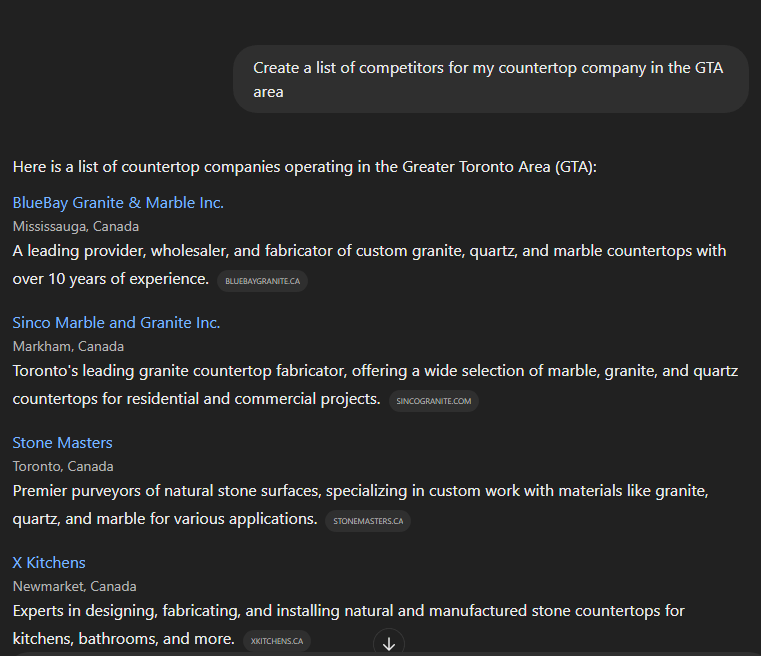
Start by identifying local and national competitors. Use AI-powered tools like SEMrush, Google Search, or ChatGPT to generate a list. For example, if you operate in Toronto, competitors might include Stone Edge Marble & Granite, Toronto Granite & Quartz, and Natural Stone City.
2. Ask AI What the Strengths and Weaknesses Are of Each Competitor
Use AI to analyze online reviews, website content, and SEO performance. For instance, AI might reveal that Toronto Granite & Quartz has strong brand recognition but slower turnaround times, while Natural Stone City excels in customization but lacks a strong social media presence.
3. Ask AI What the Trends Are for Your Local Countertop Market
AI can analyze search trends and industry reports to highlight what’s popular. For example, AI might show that demand for sustainable quartz countertops is rising in Ontario, or that waterfall-edge designs are trending in high-end homes.
4. Ask AI Where the Gaps Are in Your Market That Your Company Can Fill
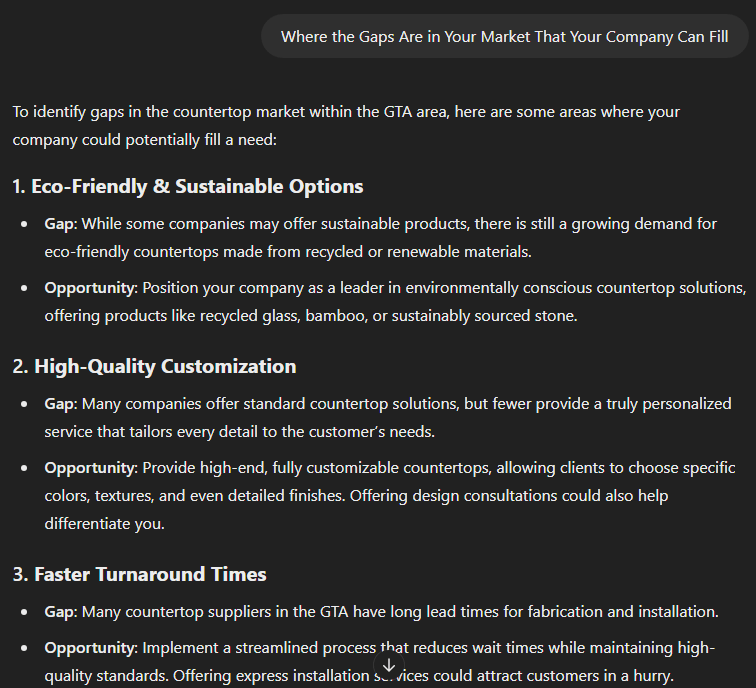
AI can compare competitor offerings and customer complaints to find opportunities. If most competitors focus on premium granite but ignore budget-friendly laminate options, this could be a niche for your business. Or, if customers complain about long installation times, offering fast-track installation services could set you apart.
5. Create a List of Actionable Insights
Based on AI’s findings, list key strategies your business can implement. Examples include:
- Launch a social media campaign targeting homeowners interested in eco-friendly countertops
- Introduce a "48-hour installation guarantee" to stand out from competitors with long wait times
- Offer augmented reality (AR) kitchen visualizations to help customers see countertops in their space before purchase
6. Order the List From Most Impactful Items to Least
Prioritize initiatives that provide the highest ROI and competitive advantage. For example, if fast installation is the biggest gap in the market, focus on optimizing your workflow before launching an AR visualization tool.
7. Execute the List
Implement changes and track progress. Use AI to monitor website traffic, ad performance, and customer feedback to refine your strategy over time.
By following these steps, countertop companies can leverage AI to outmaneuver competitors, attract more customers, and grow their market share effectively.
2) Why Use AI To Complete A Competitor Analysis
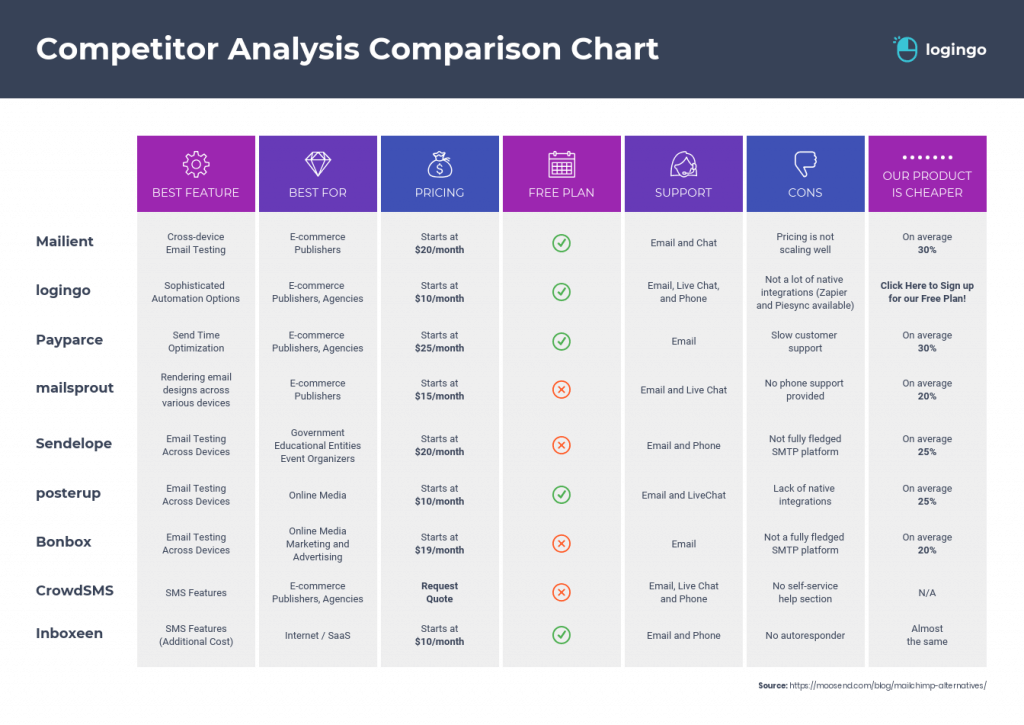
Source: Venngage
Traditional competitor analysis methods can be time-consuming and may not provide the depth of insights needed to stay competitive. AI-powered tools enable countertop businesses to gain a more comprehensive understanding of market trends, customer behaviour, and competitor strategies with greater speed and accuracy. From identifying emerging design preferences—such as the rising demand for quartz over granite—to analyzing competitor pricing models, AI streamlines the research process.
Additionally, AI enhances the efficiency of report writing by automating data collection, refining insights, and even improving grammar and readability. Tools like Ahelp’s AI-powered grammar checker ensure reports are polished and professional, which you can access here https://ahelp.com/grammar-checker/, while ClickUp AI helps generate data-driven insights.
Beyond research and reporting, AI can also enhance predictive analysis, helping countertop companies anticipate shifts in consumer demand. For example, AI can analyze search trends to forecast growing interest in sustainable countertop materials, allowing businesses to adapt their product offerings proactively. By leveraging AI, countertop businesses can reduce the time spent on competitive analysis while uncovering highly actionable opportunities to differentiate themselves in the market and gain a strategic edge.
3) Understanding the Countertop Market Through AI
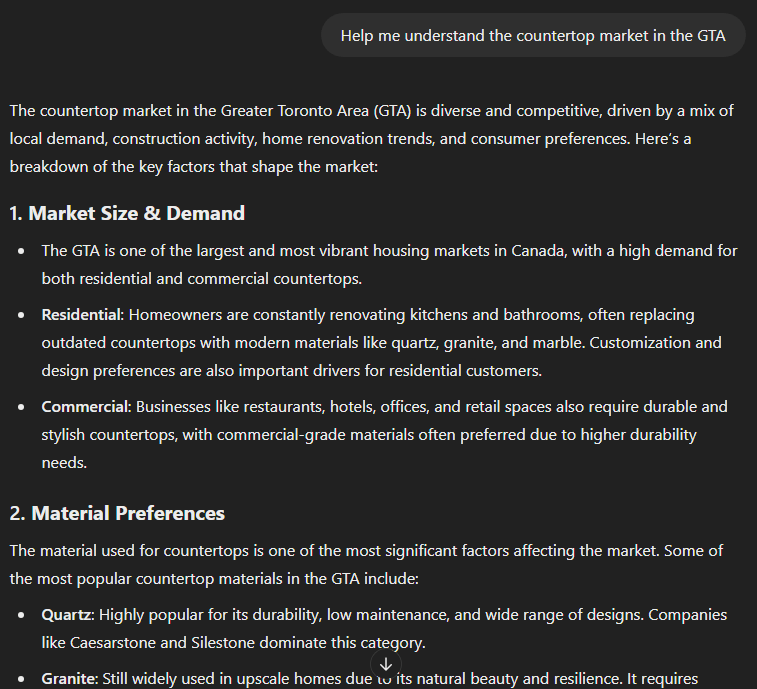
In the countertop industry, comprehending market dynamics extends beyond assessing consumer preferences and material trends; it necessitates a thorough analysis of competitors' pricing strategies. AI-driven tools facilitate this by monitoring competitors' price adjustments in response to market fluctuations, enabling businesses to fine-tune their own pricing models effectively. For instance, AI-powered platforms like Altosight offer real-time tracking of competitor prices, providing actionable insights that help maintain competitive pricing while safeguarding profit margins.
Moreover, AI enhances competitive landscape mapping by identifying key market players and evaluating their strengths and weaknesses, thereby uncovering new opportunities. These tools aggregate data from diverse sources, including industry reports and social media engagement metrics, allowing businesses to visualize their market positioning accurately. Incorporating AI into marketing strategies also leads to data-driven decision-making and more effective advertising campaigns. By analyzing real-time data, companies can discern which promotions resonate with their target audience and refine their outreach efforts accordingly. Additionally, AI-generated content ensures consistency in tone across various platforms, reinforcing brand recognition and cohesion.
By leveraging AI technologies, countertop businesses can gain a comprehensive understanding of market trends, optimize pricing strategies, and enhance their competitive positioning in an increasingly dynamic marketplace.
4) Primary Businesses Challenges in the Countertop Industry
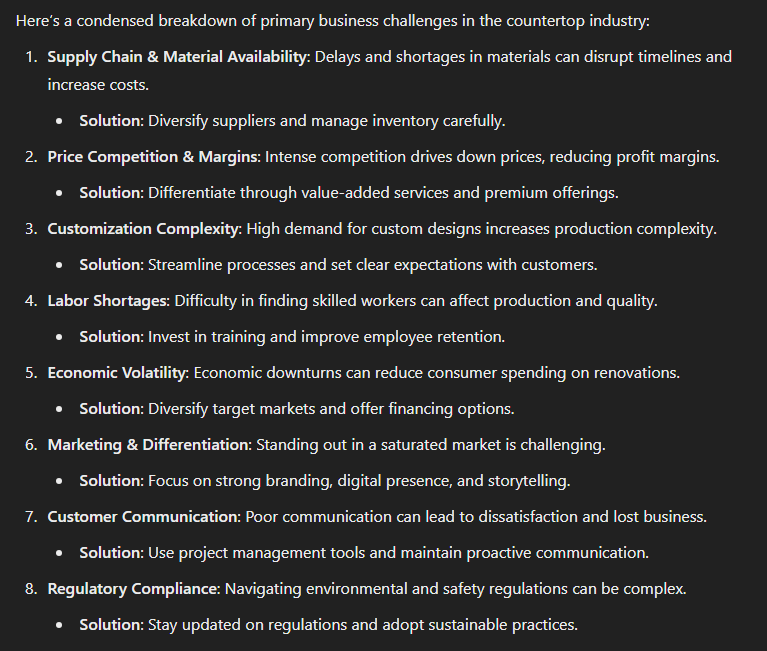
The countertop industry faces significant challenges, including supply chain disruptions, fluctuating material costs, and skilled labour shortages. Shipping delays impact pricing and delivery timelines while staying competitive requires adapting to evolving design trends and technologies. A lack of skilled installers can further slow down project completion, making workforce training and retention essential.
AI-powered tools help businesses anticipate supply chain disruptions by analyzing global data, allowing companies to adjust sourcing strategies and secure alternative materials before shortages arise. AI-driven workforce management solutions optimize scheduling and improve training through virtual simulations, accelerating employee onboarding and enhancing efficiency (OSHA Ask).
AI also strengthens marketing and competitive analysis by providing data-driven insights into consumer preferences and competitor strategies. With AI-driven decision-making, countertop businesses can refine pricing, streamline operations, and develop targeted marketing campaigns, ensuring they remain competitive in an ever-changing market.
5) What’s in a Countertop?

Source: Silestone
The cost of a countertop depends first and foremost on the material. For example, natural stone options like granite and marble are expensive due to their trending aesthetics, while quartz and solid surfaces offer easier maintenance for a lower price. Installation complexity, edge profiles and finishes, and level of customization also factor in. Supply chain fluctuations, labour and craftsmanship costs, and regional market demand all impact the final pricing.
Sustainability and innovation have left a condensation ring on the industry’s surface in recent years. Engineered materials like quartz are gaining popularity due to their durability. Recycled and eco-friendly options draw attention as homeowners and businesses prioritize sustainability. Customization is an ever-growing demand, with consumers seeking unique patterns, textures, and colours that fit modern kitchen and bathroom designs. People now buy countertops through direct-to-consumer sales and online purchasing — so, digital engagement is very important for modern businesses.
6) How AI Is Changing Competitive Analysis
Transform and improve your competitive analysis with ChatGPT
AI revolutionizes competitive landscape mapping by analyzing vast amounts of digital data with speed and precision. Instead of manually tracking competitor websites for pricing and product updates or sifting through customer reviews, AI automates this process in real time. This allows countertop businesses to identify emerging market trends and service gaps faster, creating opportunities for growth.
Consumer preferences shift rapidly, and AI helps businesses stay ahead by tracking purchasing patterns and customer behaviour. AI tools monitor which countertop materials, colours, and finishes are trending, enabling companies to adjust product offerings proactively. For example, businesses can introduce new designs before they become mainstream, gaining a competitive advantage.
As more consumers research and purchase countertops online, AI-powered chatbots and virtual design assistants enhance customer engagement. AI-driven recommendation engines suggest countertop styles based on customer preferences, creating a more personalized shopping experience. Additionally, AI automates responses to common customer inquiries, improving satisfaction through faster and more efficient service.
7) The Future of AI in Competitive Analysis
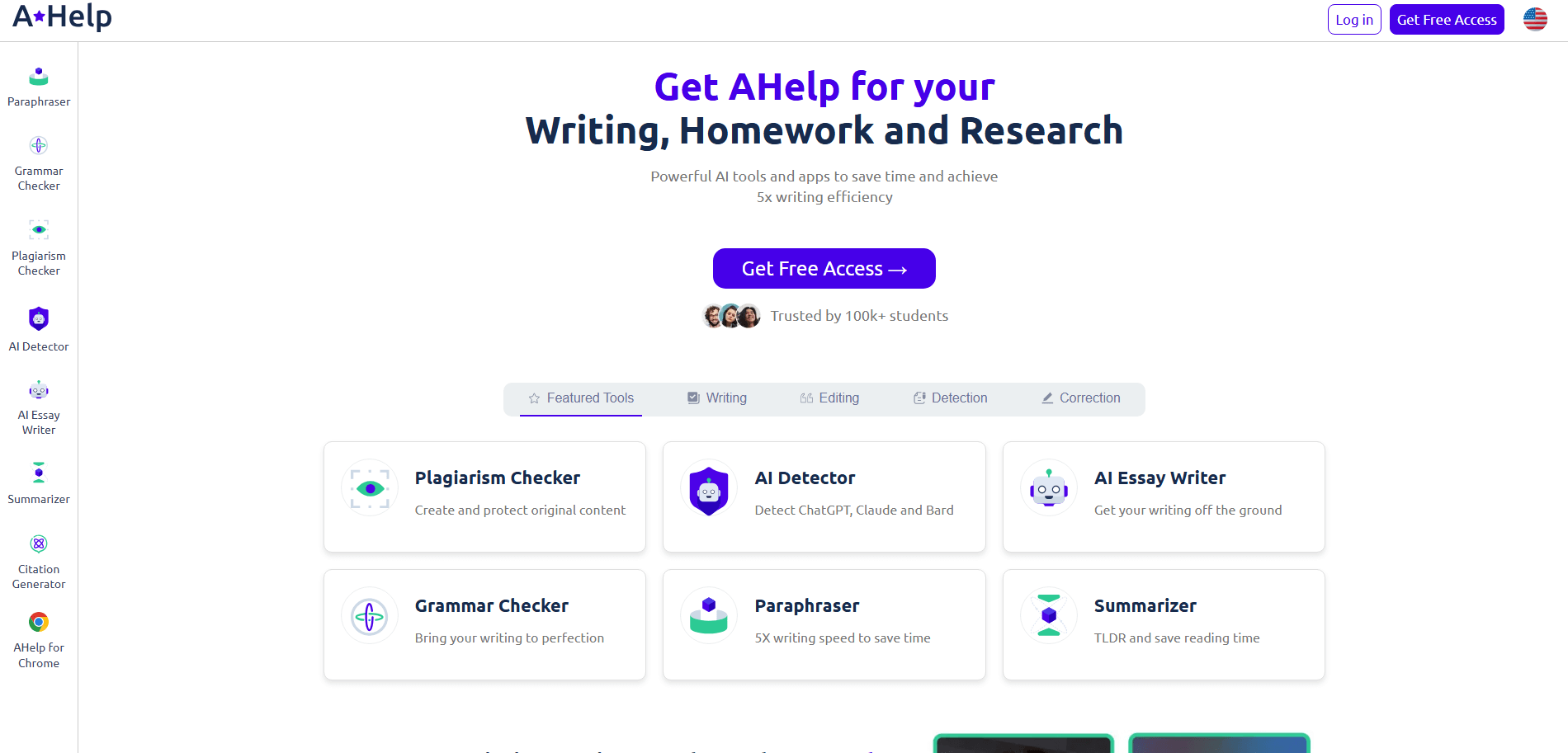 Source: Ahelp
Source: Ahelp
AI is transforming how businesses analyze their industries, offering more precise and customizable tools to track market shifts. Companies that integrate AI into their competitive analysis will be better positioned to navigate industry changes and outperform competitors—including those in the countertop sector.
The ability to predict trends in real-time is a major advantage. AI enables businesses to track emerging design preferences, pricing strategies, and consumer behaviour, allowing for rapid adjustments to marketing and product offerings. In an industry as competitive as countertops, where companies constantly compete on materials, pricing, and innovation, AI-driven insights can provide a crucial edge.
The growing popularity of home improvement and renovation content online has intensified competition in the countertop market. To capture consumer attention, businesses must adopt data-driven marketing strategies powered by AI. AI tools can refine messaging, improve ad targeting, and optimize content for engagement. To enhance industry analysis and communication, try an AI-powered grammar checker like Ahelp. Embracing AI for market research, competitive analysis, and customer engagement will be essential for countertop companies looking to lead in an increasingly crowded market.
- Details
- Online Advertising
- Hits: 901
How Dynamics 365 Marketing Consulting Transforms Business Outcomes for Your Countertop Company
The #1 tip for Microsoft Dynamics consulting is it can streamline a countertop company's operations by integrating sales, inventory, and customer data, leading to improved efficiency, better decision-making, and enhanced customer experiences. Businesses need smart tools to succeed in marketing. Dynamics 365 Marketing offers features to connect with customers, manage campaigns, and analyze data. But using it effectively can be challenging without expert guidance. Consultants help businesses make the most of this platform by aligning it with their goals, optimizing processes, and improving campaigns. This leads to clearer workflows and stronger customer relationships. In this article, we’ll explore how consulting helps turn Dynamics 365 Marketing into a powerful tool for measurable results.
Click on each corresponding link to jump ahead:
- Understanding Dynamics 365 Marketing
- The Role of Dynamics 365 Marketing Consulting
- Key Areas Where Consulting Transforms Business Outcomes
- Choosing the Right Dynamics 365 Marketing Consultant
- Future of Marketing with Dynamics 365
If you are looking for help with finding the right consultant for Dyanmcis 365 Marketing, Contact Profitworks!
1) Understanding Dynamics 365 Marketing
Dynamics 365 Marketing is a feature-rich platform designed to improve how countertop businesses connect with their audiences. It offers a range of tools, such as email marketing, lead tracking, campaign automation, and customer segmentation. These features help countertop companies streamline workflows, target specific customer groups, and gain insights from data analytics to improve their marketing strategies.
However, even with these advanced capabilities, many companies face challenges in fully utilizing the platform. Common issues include difficulty with implementation, underuse of automation tools, and a lack of alignment with business objectives. Dynamics 365 Marketing consulting services address these challenges by providing expert guidance. Consultants ensure the platform is configured correctly, customized to specific needs, and used to its maximum potential.
For example, consultants can assist countertop businesses with creating data-driven campaigns, improving customer engagement strategies, and integrating the platform with existing tools like Dynamics 365 Sales. By leveraging their expertise, countertop companies can transform their marketing operations, boost efficiency, and deliver better results with Dynamics 365 Marketing.
2) The Role of Dynamics 365 Marketing Consulting
Dynamics 365 Marketing consulting services play a vital role in helping countertop businesses optimize their use of the platform. Dynamics consultants bring a wealth of expertise to ensure that companies not only implement the system correctly but also adapt it to meet their specific needs and objectives, such as targeting the right customers and improving lead generation.
Dynamics Marketing Consultants guide countertop companies through every stage of the process, from initial setup to ongoing optimization. They help identify gaps in current marketing strategies and demonstrate how the platform’s features can fill those gaps. For instance, a consultant might configure automated workflows to reduce repetitive tasks, set up lead-scoring models to prioritize high-value prospects or automate personalized follow-up emails to nurture potential clients.
Additionally, these services often include Dynamics staffing and training to ensure teams are comfortable using the platform’s tools. This hands-on support reduces the learning curve and ensures that businesses can maintain and improve their marketing strategies over time.
Whether it’s aligning campaigns with customer behaviours, improving personalization, or enhancing data analytics, consulting ensures that countertop businesses maximize their return on investment with Dynamics 365 Marketing.
3) Key Areas Where Consulting Transforms Business Outcomes
Dynamics 365 Marketing is a versatile platform, but its true potential is unlocked with expert guidance. Consulting services help countertop businesses make the most of the platform’s features, driving significant improvements in their marketing efforts. From enhancing campaign results to simplifying daily tasks through automation, consultants bring practical strategies that lead to real-world success. Let’s explore the specific areas where consulting makes the biggest difference for countertop companies.
a) Enhanced Campaign Effectiveness
Consultants improve the success of marketing campaigns by refining strategies and optimizing tools within Dynamics 365 Marketing. They use the platform’s data analytics to identify what resonates with specific customer groups, such as homeowners or contractors looking for countertop solutions. By setting up segmentation and personalization features, consultants ensure that campaigns deliver the right message to the right people, boosting engagement and conversions for promotions, product launches, or seasonal offers.
b) Improved Customer Journey Mapping
Understanding the customer journey is vital for crafting effective marketing strategies in the countertop industry. Consultants help businesses use Dynamics 365 Marketing to visualize and analyze the entire customer experience, from initial contact to final purchase. By identifying key touchpoints—such as showroom visits, quote requests, or product samples—they enable countertop companies to create targeted actions that guide customers through the buying process smoothly, ultimately driving more conversions.
c) Simplified Processes Through Automation
Automation is a core strength of Dynamics 365 Marketing, but it often requires expert setup. Consultants configure workflows to handle repetitive tasks, such as sending follow-up emails, scheduling consultations, or assigning leads to the sales team. This not only saves time but also ensures consistency in how tasks are performed, allowing countertop companies to focus on high-value activities like consultations or custom orders.
d) Data-Driven Decision Making
With the advanced analytics tools in Dynamics 365 Marketing, countertop companies can gain valuable insights into campaign performance and customer behavior. Consultants help set up dashboards and reporting systems that make this data easy to access and understand. These insights allow businesses to adjust their strategies quickly and achieve better outcomes, such as refining targeting for specific countertop materials or promotional offers.
e) Integration with Other Systems
Dynamics 365 Marketing works best when integrated with other tools like Dynamics 365 Sales or implementing Dynamics 365 Salesforce integration. Consultants facilitate these integrations, ensuring data flows smoothly between systems. This connected environment enhances collaboration between teams and provides a clearer view of the customer lifecycle.
4) Choosing the Right Dynamics 365 Marketing Consultant

Source: Profitworks
Choosing the Right Dynamics 365 Marketing Consultant
Selecting the right consultant is a critical step in ensuring success with Dynamics 365 Marketing. With so many options available, businesses need to focus on finding a partner with the right expertise and approach.
What to Look for in a Consultant
- Proven Experience: Look for consultants with a track record of successful Dynamics 365 Marketing implementations. Case studies or client testimonials can provide insight into their capabilities.
- Industry Knowledge: A consultant with experience in your industry will better understand your challenges and how to address them using the platform.
- Technical Expertise: Ensure they have a deep understanding of Dynamics 365 Marketing and its integrations with other tools in the Microsoft ecosystem.
Questions to Ask Potential Consultants
- How many Dynamics 365 Marketing projects have you completed?
- What industries have you worked with, and how do you tailor solutions for different businesses?
- Can you provide training for my team to use the platform effectively?
- What support do you offer after the initial implementation?
Benefits of Choosing the Right Partner
A skilled consultant will help you set realistic goals, design efficient workflows, and ensure your team is confident in using the platform. They can also offer ongoing support to adapt your strategies as your business grows. Taking the time to evaluate potential consultants ensures a smoother implementation and better results.
5) Future of Marketing with Dynamics 365
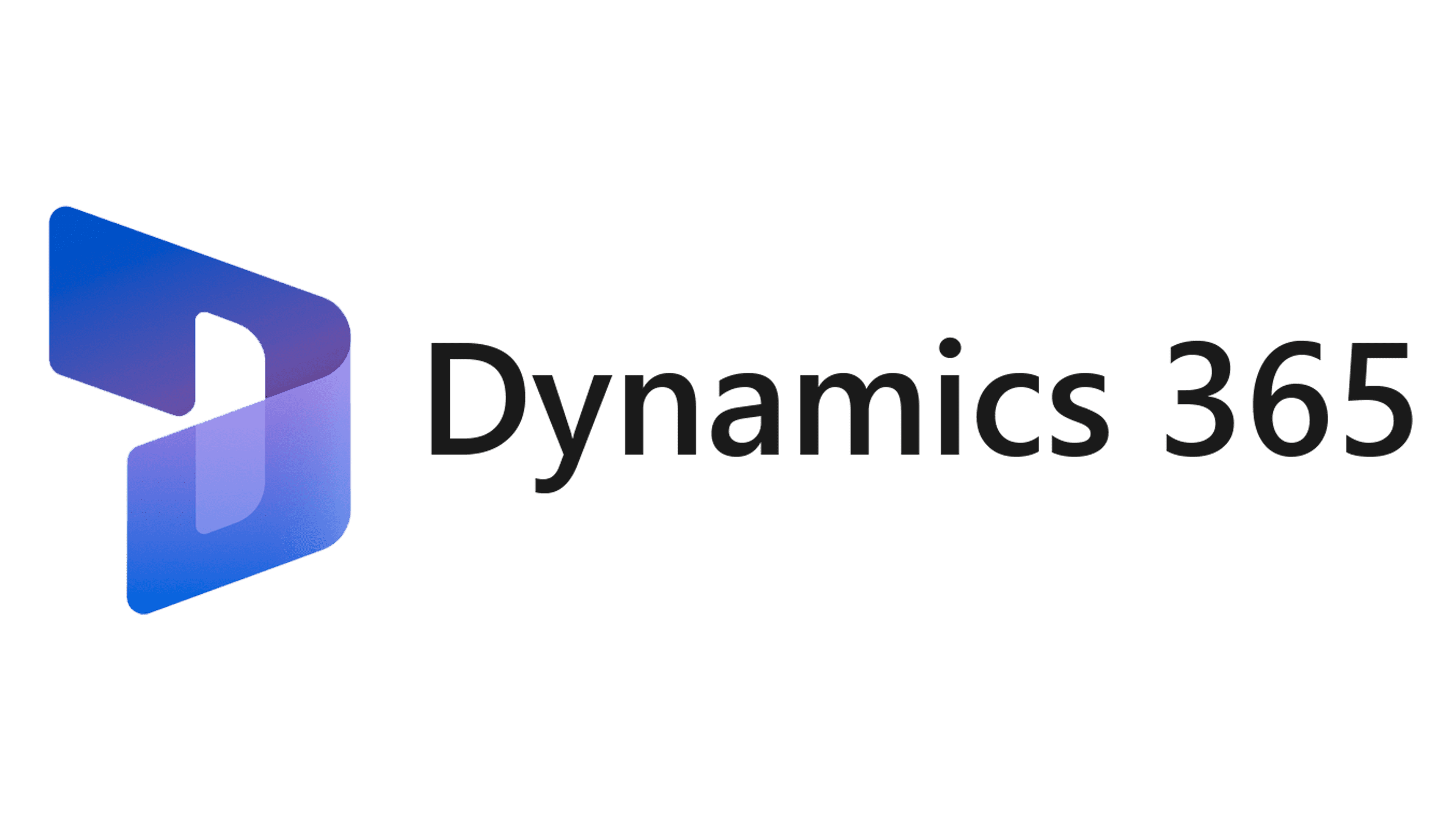
Source: Microsoft
Marketing continues to evolve as technology advances and customer expectations grow. Dynamics 365 Marketing provides countertop companies with the tools needed to adapt to these changes, offering features that support more personalized, data-driven, and efficient marketing strategies. Artificial intelligence, for example, is playing a bigger role in analyzing customer behaviours and predicting trends, such as identifying which countertop materials are trending or which customer segments are most likely to convert. Similarly, personalization is no longer optional—it’s expected, and countertop businesses must deliver experiences that resonate with individual customers, whether they’re looking for granite countertops or custom designs.
The integration of marketing tools with other platforms, such as Power BI and Dynamics 365 Sales, will become increasingly important for countertop companies. These connected systems create unified workflows and provide businesses with a comprehensive view of their operations, enabling smarter decisions, such as managing inventory based on demand or tracking customer preferences more effectively.
Consulting services will continue to play a key role in helping countertop businesses navigate these changes. As new features and trends emerge, consultants will ensure companies stay competitive by adapting strategies and leveraging the platform’s full capabilities. With the right combination of technology and expert guidance, countertop companies can prepare for a future of smarter, more impactful marketing.
Author's name - Ivan Farafonov
About the author - I'm passionate about sharing my extensive experience in Microsoft and Dynamics 365 technologies. Beyond the technical realm, I excel in recruiting and building high-performing teams, ensuring every project is executed with precision and collaboration. As a contributor to HireDynamicsDevelopers, I share my insights on maximizing Dynamics 365’s potential, blending technical expertise with strategic team development. My passion lies in both technology and fostering talented professionals to achieve outstanding results.
Linkedin: https://www.linkedin.com/in/ivan-farafonov-mobilunits/



